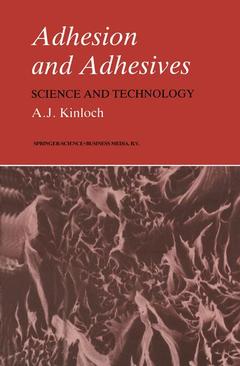Adhesion and Adhesives, Softcover reprint of hardcover 1st ed. 1987 Science and Technology
Langue : Anglais
Auteur : Kinloch Anthony J.

Over the last decade, or so, the growth in the use of adhesives, especially in ever more technically demanding applications, has been rapid and many major developments in the technology of adhesives have been reported. This growth has also led to attention being focused on somewhat more basic studies of the science of adhesion and adhesives, and in recent years our level of fundamental knowledge concerning the formation and mechanical performance of adhesive joints has increased dramatically. Such studies have, of course, been aided greatly by the development of the tools at the disposal of the investigators. For example, specific surface analytical techniques, such as X-ray photoelectron and secondary-ion mass spectroscopy, and the increasingly sophisticated methods of stress analysis and fracture mechanics have been put to good use in furthering our understanding of the science of adhesion and adhesives. The present book attempts to review the multidisciplined subject of adhesion and adhesives, considering both the science and technology involved in the formation and mechanical performance of adhesive joints. The author would like to thank his friends and colleagues for useful discus sions and help in the preparation of this book. I am particularly grateful to P. Cawley, J. Comyn, W. A. Lees, A. C. Roulin-Moloney, W. C. Wake, J. G. Williams and R. J. Young who have read and commented on various chapters and P. Farr for preparing the diagrams.
1 Introduction.- Bibliography of general background books.- 2 Interfacial contact.- 2.1 Introduction.- 2.2 Surface tension.- 2.3 Wetting equilibria.- 2.3.1 Theoretical considerations.- 2.3.2 Experimental considerations.- 2.3.3 Effect of surface roughness.- 2.4 Surface and interfacial free energies.- 2.4.1 Low-energy surfaces.- 2.4.2 High-energy surfaces.- 2.4.3 Orientation at interfaces.- 2.4.4 Applicability to adhesives technology.- 2.5 Kinetics of wetting.- 2.5.1 Surface tension gradients.- 2.5.2 Dynamic contact angles.- 2.5.3 The influence of surface roughness.- 2.5.4 Time—temperature considerations.- 2.6 The bonding operation.- 2.6.1 Air entrapment.- 2.6.2 The bonding environment.- 2.7 Concluding remarks.- References.- 3 Mechanisms of adhesion.- 3.1 Introduction.- 3.2 Mechanical interlocking.- 3.2.1 Introduction.- 3.2.2 Plating of plastics.- 3.2.3 Mechanically roughened substrates.- 3.2.4 Chemically roughened substrates.- 3.2.5 The role of localized energy dissipation.- 3.2.6 Summary.- 3.3 Diffusion theory.- 3.3.1 Introduction.- 3.3.2 Modelling interfacial diffusion.- 3.3.3 Direct experimental evidence.- 3.3.4 Criticisms of the diffusion theory.- 3.3.5 Welding of plastics.- 3.3.6 Polymer/metal interfaces.- 3.3.7 Summary.- 3.4 Electronic theory.- 3.4.1 Introduction.- 3.4.2 Deryaguin’s studies.- 3.4.3 Weaver’s studies.- 3.4.4 Criticisms of the electronic theory.- 3.4.5 Summary.- 3.5 Adsorption theory.- 3.5.1 Introduction.- 3.5.2 Secondary force interactions.- 3.5.3 Donor—acceptor interactions.- 3.5.4 Primary force interactions.- 3.5.5 Molecular complexes.- 3.6 Concluding remarks.- References.- 4 Surface pretreatments.- 4.1 Introduction.- 4.2 Low-energy surfaces.- 4.2.1 Introduction.- 4.2.2 Fluorocarbon polymers.- 4.2.3 Polyolefins.- 4.2.4 Other plastic substrates.- 4.2.5 Plastic laminate materials.- 4.2.6 Rubbers.- 4.2.7 Plasma treatments.- 4.3 High-energy surfaces.- 4.3.1 Introduction.- 4.3.2 Solvent cleaning.- 4.3.3 Mechanical abrasion.- 4.3.4 Chemical treatments.- 4.3.5 Primers.- 4.3.6 Plasma treatments.- 4.4 Concluding remarks.- References.- 5 Hardening of the adhesive.- 5.1 Introduction.- 5.2 Hardening by solvent or dispersing medium removal.- 5.2.1 Introduction.- 5.2.2 Examples.- 5.3 Hardening by cooling.- 5.3.1 Introduction.- 5.3.2 Examples.- 5.4 Hardening by chemical reaction.- 5.4.1 Introduction.- 5.4.2 Examples.- 5.5 Non-hardening adhesives.- 5.6 Concluding remarks.- References.- 6 Mechanical behaviour of adhesive joints.- 6.1 Introduction.- 6.2 Common joint designs.- 6.3 Standard test methods.- 6.4 Stresses in adhesive joints.- 6.4.1 Introduction.- 6.4.2 Engineering properties of the adhesive.- 6.4.3 Axially loaded butt or poker-chip joints.- 6.4.4 Single lap joints.- 6.4.5 Double lap joints.- 6.4.6 Modified lap joints.- 6.4.7 Peel joints.- 6.4.8 Miscellaneous joint geometries.- 6.4.9 Internal stresses.- 6.4.10 Comparison of joint test geometries.- 6.5 Non-destructive testing.- 6.5.1 Introduction.- 6.5.2 Inspection of pretreated substrates.- 6.5.3 Inspection of adhesive joints.- 6.6 Concluding remarks.- References.- 7 Fracture mechanics of adhesive joints.- 7.1 Introduction.- 7.2 Theoretical considerations.- 7.2.1 Introduction.- 7.2.2 Energy balance approach.- 7.2.3 Stress intensity factor approach.- 7.2.4 Width effects.- 7.2.5 Relationships between G and K.- 7.3 Experimental considerations.- 7.3.1 Introduction.- 7.3.2 Flexible joints.- 7.3.3 Rigid joints.- 7.4 Typical values of Gc and Kc.- 7.5 Effect of joint geometry.- 7.5.1 Introduction.- 7.5.2 Flexible peel joints.- 7.5.3 Structural adhesives.- 7.5.4 Modes of loading.- 7.6 Effect of rate and temperature.- 7.6.1 Introduction.- 7.6.2 Rubbery adhesives.- 7.6.3 Rigid adhesives.- 7.7 Concluding remarks.- References.- 8 The service life of adhesive joints.- 8.1 Introduction.- 8.2 Fatigue.- 8.2.1 Dynamic fatigue.- 8.2.2 Static fatigue.- 8.3 Environmental attack.- 8.3.1 Introduction.- 8.3.2 General observations.- 8.3.3 Mechanisms of attack.- 8.3.4 Kinetics of attack.- 8.3.5 The role of stress.- 8.3.6 Service life predictions.- 8.4 Concluding remarks.- References.- Notations.- English alphabet.- Greek alphabet.- Abbreviations.- Author index.
Date de parution : 12-2010
Ouvrage de 442 p.
15.5x23.5 cm
© 2024 LAVOISIER S.A.S.
